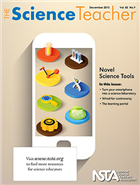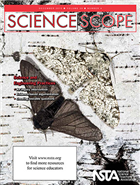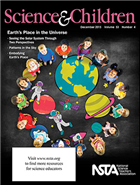Ideas and info from NSTA’s December K-12 journals
By Mary Bigelow
Posted on 2015-12-28
 The Science Teacher: Novel Science Tools
The Science Teacher: Novel Science Tools
I once worked with a teacher who said that he would put off doing anything with technology until “things settled down.” I suspect he’s still waiting… The featured articles in this issue look at some current (as of now anyway) technologies that related to teaching and learning in science, such as mapping tools, digital probeware and sensors, and online simulations. The lessons show their connections to the NGSS.
- Wired for Controversy describes the materials and methodology used to explore ethics in autonomous systems through cyborg roaches and robotic insects. Sounds almost like science fiction!
- Turn Your Smartphone Into a Science Laboratory has several activities in which students collect and analyze data related to force and motion as al alternative to more expensive probes or monitors. We can use our phones in class!
- Where the Birds Live is another phone-enhanced activity in which students use real data and online maps to explore bird habitats, migration patterns, and biodiversity.
- Clearing the Air explores the greenhouse effect in the context of black-body radiation and Wien’s Law in a 5E lesson using online simulations.
- The Learning Portal describes a source of free classroom-tested web-based activities that use probes and models.
- Science 2.0: Did They Really Read It? Describes two online tools to assess student comprehension of reading and video resources. (See the authors’ related blog).
For more on the content that provides a context for these projects and strategies see the SciLinks websites for Acceleration, Birds, Biodiversity, Blackbody Radiation, Centripetal Force, Conduction Convection and Radiation, DNA Replication, Forces and Motion, Gravity, Greenhouse Effect, Max Planck, Migration of Birds.
Continue for Science Scope and Science and Children
 Science Scope: Science and Engineering Practices
Science Scope: Science and Engineering Practices
Assessing Science Practices: Moving Your Class Along a Continuum groups the eight science and engineering practices into three categories: investigating, sensemaking, and critiquing. The authors include an assessment tool and describe how it can be used during a lesson.
Other featured articles:
- Present, Critique, Reflect, and Refine is a four-step strategy to teach evidence-based argumentation.
- Authentic Science Investigation in the Classroom: Tools for Creating Original, Testable Questions and Graphical Hypotheses discusses the importance of asking questions and includes suggestions (such as flowcharts and inquiry boards) for helping student refine questions into testable ones.
- Argumentation and Explanation: Tools for Using Them Together While Keeping Them Separate includes graphic organizers and an example of an explanation template.
- The ICAN Intervention: Helping Science Learners Make Connections to Content During Inquiry has examples of “probes” that help students chart and reflect on their learning
- Everyday Engineering: Queuing Theory—Is My Line Always the Slowest? takes engineering concepts to the supermarket.
- Tried and True: Puff Mobile Derby Student Engineers demonstrate their learning by applying concepts from physics and engineering to the design of wind-powered vehicles.
For another engineering project, see Engineering Encounters: Creating a Prosthetic Hand from Science & Children.
For more on the content that provides a context for these projects and strategies see the SciLinks websites for Forces and Motion, Plant Growth, Plate Tectonics.
 Science and Children: Earth’s Place in the Universe
Science and Children: Earth’s Place in the Universe
As always, the articles in this issue have ideas for classroom activities that align with the NGSS, along with photos of students, examples of their work, rubrics, and downloadable resources.
- Patterns in the Sky
has a 5E lesson for maximizing young students’ experiences before, during, and after a visit to a planetarium. - Seeing the Solar System Through Two Perspectives describes how a focus on learning progressions in modeling and observing patterns can help students develop their understanding of interactions between the Earth, sun, moon, and stars. (Part 2 will be published in a later issue).
- Embodying Earth’s Place in the Solar System shows how students can explore seasonal changes in how we see constellations.
- Fossil Explorers uses a 5E lesson to build on students’ curiosity about prehistoric life.
- Map That Find! has 5E lesson ideas for student archaeologists to apply their skills in observation, reasoning, hypothesis-testing, and mapping.
- Teaching Through Trade Books: Sunrise, Sunset, and Shadows has two activities with suggestions for related books in which K-2 students investigate what causes and affects shadows and 3-5 students examine the correlations between the amount of daylight and the seasons.
- The Early Years: The Earth-Sun System has ideas for younger learners as they investigate shadows.
- Formative Assessment Probes: Mountaintop Fossil: A Puzzling Phenomenon explores students’ knowledge of how fossils form and what we can learn from where they are found.
From the Science Teacher: Career of the Month: Earthquake Engineer
For more on the content that provides a context for these projects and strategies see the SciLinks websites for Archaeology, Constellations, Fossil Discoveries, Fossils, Fossil Record, Planets, Properties of Light, Seasons, Stars, Sun, Using Models in Earth Science.
Disclaimer: The views expressed in this blog post are those of the author(s) and do not necessarily reflect the official position of the National Science Teaching Association (NSTA).


